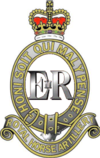| Royal Horse Artillery | |
|---|---|
 Cypher of the Royal Horse Artillery | |
| Active | 1 February 1793 – present |
| Allegiance | |
| Branch | |
| Type | Horse artillery |
| Role | The King's Troop - Ceremonial 1st Regiment - Field Artillery 3rd Regiment - Field Artillery 7th Regiment - Airborne Artillery |
| Size | Three Regiments and one Ceremonial Battery plus affiliated TA Units |
| Part of | Royal Artillery |
| Garrison/HQ | The King's Troop - London 1st Regiment - Larkhill 3rd Regiment - Newcastle Upon Tyne 7th Regiment - Colchester |
| Motto(s) | French: Honi soit qui mal y pense "Shamed be whoever thinks ill of it." |
| March | Bonnie Dundee (Gallop march); The Keel Row (Trot March); The Royal Artillery Slow March sometimes referred to as Duchess of Kent March (walk march) |
| Commanders | |
| Captain General, Royal Artillery | The King |
| Colonel Commandant | General Sir Alexander Harley, KBE, CB |
| Insignia | |
| Tactical Recognition Flash |  |

The Royal Horse Artillery (RHA) was formed in 1793 as a distinct arm of the Royal Regiment of Artillery (commonly termed Royal Artillery) to provide horse artillery support to the cavalry units of the British Army.[1] Although the cavalry link remained part of its defining character, as early as the Battle of Waterloo the RHA was sometimes deployed more along the lines of conventional field artillery, fighting from comparatively fixed positions.[2]
The Royal Horse Artillery, currently consists of three regiments, (1 RHA, 3 RHA and 7 RHA) and one ceremonial unit (King's Troop, Royal Horse Artillery). Almost all the batteries of the Royal Horse Artillery have served continuously since the French Revolutionary Wars or Napoleonic Wars, except the King's Troop, created in 1946, and M Battery, which was 'reanimated' in 1993. Horses are still in service for ceremonial purposes but were phased out from operational deployment in the 1930s.
- ^ "Royal Artillery". National Army Museum.
- ^ Kinard, Jeff (2007). Artillery: An Illustrated History of Its Impact. Santa Barbara, California: ABC-CLIO. p. 139.
